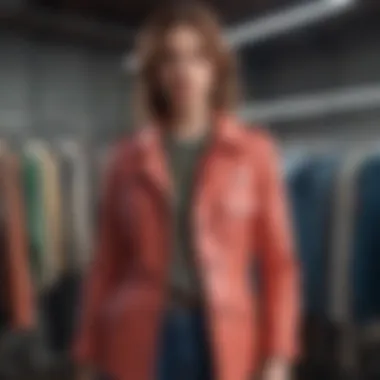Unveiling the Allure of Second-Hand Clothing Sales: A Sustainable Fashion Exploration


Understanding Personal Finances
In the realm of second-hand clothing sales, understanding personal finances plays a crucial role in making informed decisions about budgeting, expenses, and financial goals. Budgeting techniques are fundamental in managing one's finances efficiently, ensuring that resources are allocated wisely. Tracking expenses is equally important as it provides a comprehensive view of where money is being spent, aiding in identifying areas for potential savings. Setting financial goals serves as a roadmap for achieving desired outcomes, whether it be saving for a specific purchase or planning for long-term financial stability.
Investing Strategies
Navigating the landscape of second-hand clothing sales involves considering various investing strategies to expand financial opportunities. An introduction to investing is essential to grasp the basics of investment options, risk management, and the potential returns. Understanding risk management safeguards investments against unforeseen market fluctuations, mitigating financial losses. Diversification is key to spreading risk across different assets, enhancing portfolio resilience and maximizing growth potential.
Retirement Planning
In the context of second-hand clothing sales, integrating retirement planning ensures a secure financial future. From retirement savings plans to social security benefits, it is crucial to strategize for post-career financial stability. Assessing healthcare costs and factoring them into retirement plans is vital in maintaining overall financial well-being.
Financial Products Overview
Expert Insights and Tips
Amidst the realm of second-hand clothing sales, seeking expert insights and tips can provide invaluable guidance for financial decision-making. Financial advisor recommendations offer personalized strategies to align financial goals with investment opportunities. Analyzing market trends allows for informed investment decisions, leveraging insights to capitalize on emerging opportunities. Formulating tax planning strategies ensures optimal financial efficiency, minimizing tax liabilities and maximizing returns for sustainable financial growth.
Understanding Second-hand Clothing Market
The exploration of the second-hand clothing market serves as a crucial focal point in unraveling the complex dynamics of sustainable fashion. By delving into this sector, one can grasp the intricate interplay between consumer behavior, environmental impact, and economic viability. Understanding the second-hand market involves analyzing the roots of its growth, the shifting paradigms in consumer preferences, and the overarching significance of promoting a circular economy. It beckons the discerning individual to ponder upon the larger implications of their fashion choices, transcending mere trends to embrace a more conscious ethos towards apparel consumption.
Rise of Second-hand Fashion
Increasing Popularity
The surge in popularity of second-hand fashion epitomizes a paradigm shift in consumer mindsets towards more ethical and sustainable shopping practices. This movement reflects a desire for uniqueness, quality, and environmental conscientiousness. The increasing popularity of second-hand clothing not only diversifies personal style but also fosters a sense of community and shared values among individuals advocating for a greener future. Though challenges exist in dispelling traditional biases against 'used' items, the allure of exclusive finds and reduced environmental impact propels the ascent of second-hand fashion.
Shift in Consumer Behavior
The evolution in consumer behavior regarding second-hand apparel mirrors a broader societal transition towards mindful consumption. The shift signifies a departure from fast-paced, mass-produced garments towards a more thoughtful and deliberate approach to dressing. Consumers are redefining fashion norms by prioritizing sustainable choices, seeking longevity over fleeting trends, thereby shaping a more sustainable sartorial landscape. While navigating this shift requires a break from conventional shopping habits, the resulting benefits in terms of personal style expression and environmental preservation are undeniable.
Environmental Impact


Reducing Fast Fashion Waste
At the core of the environmental impact of second-hand clothing lies the imperative goal of curtailing fast fashion waste. By extending the lifecycle of garments through resale and reuse, individuals actively combat the rampant waste generation endemic to the conventional fashion industry. This conscious effort not only reduces textile pollution and landfill overflow but also fosters a culture of resourcefulness and mindful consumption. While challenges in altering consumer behaviors persist, the long-term ecological benefits of reducing fast fashion waste through second-hand trade cannot be overstated.
Promoting Sustainability
Promoting sustainability within the realm of second-hand fashion entails advocating for a fundamental reevaluation of fashion's linear production-consumption-disposal model. By endorsing thrifted clothing, individuals actively propagate the ethos of circularity and responsible consumption. The promotion of sustainability through second-hand garments underscores the need for systemic change in fashion practices, encouraging a shift towards a more eco-conscious and ethically driven industry. While obstacles exist in mainstreaming sustainable fashion practices, each pre-owned purchase represents a step towards a greener future.
Economic Benefits
Cost-Effective Shopping
Among the compelling factors driving the embrace of second-hand fashion is the allure of cost-effective shopping. By venturing into the realm of thrift and resale, individuals access a treasure trove of budget-friendly yet quality pieces that defy exorbitant price tags. Cost-effective shopping not only expands one's wardrobe options but also nurtures a mindset of value-driven consumerism, prioritizing quality and sustainability over fleeting trends. Embracing thrifted finds presents a practical solution to fashion's affordability conundrum, democratizing style and fostering financial prudence.
Income Generation
The prospect of income generation through selling and buying second-hand clothing underscores the economic viability of sustainable fashion practices. Individuals partaking in the resale economy not only declutter their wardrobes and earn supplemental income but also contribute to the circularity of fashion, extending the lifespan of garments and promoting ethical consumption patterns. Income generation in the second-hand clothing market fuels a decentralized and participatory economy, where each transaction fosters a sense of community and economic empowerment. Embracing second-hand sales as a means of income generation signifies a departure from traditional consumerist behaviors towards more mindful and sustainable economic activities. Each transaction becomes a testament to the transformative power of conscious consumer choices in shaping a more equitable and environmentally conscious society.
Navigating Second-hand Shopping
To understand the essence of navigating second-hand shopping contributes vitally to this article by unveiling the intricate process of finding hidden treasures in the world of pre-owned garments. As buyers maneuver through racks of clothing, the significance lies in distinguishing quality pieces from the array of options available. Navigating second-hand shopping encapsulates the essence of sustainable fashion by promoting the reuse and revaluation of clothing items, steering individuals away from the fast fashion frenzy. It empowers shoppers to make conscious choices aligned with environmental sustainability and personal style authenticity, fostering a shift towards a more eco-conscious approach to fashion consumption.
Finding Quality Pieces
In delving into the realm of finding quality pieces within second-hand shopping, an emphasis is placed on honing the skill of inspecting garment condition. The act of meticulously examining the state of a garment ensures buyers procure items that meet their expectations in terms of durability, aesthetics, and overall value. By scrutinizing seams, fabric integrity, and potential wear and tear, shoppers can make informed decisions, elevating their shopping experience and maximizing the longevity of their purchases. Researching brands and materials complements the quest for quality by allowing shoppers to discern superior craftsmanship, materials, and design aesthetics, guiding their selections towards brands that resonate with their values and preferences. This aspect enriches the shopping journey, creating a nuanced and rewarding experience.
Inspecting Garment Condition
Delving deeper into inspecting garment condition unveils a meticulous process that underpins the foundation of finding quality pieces in second-hand shopping. By assessing the stitching, fabric quality, presence of stains or damages, and overall wear of the garment, buyers can ensure their selections align with their desired standards. This meticulous evaluation empowers shoppers to avoid purchasing subpar items and invest in pieces that align with their expectations of longevity and aesthetic appeal. The thoughtful consideration of garment condition not only enhances the shopping experience but also contributes to sustainable fashion practices, promoting the extended use of clothing items.
Researching Brands and Materials
Researching brands and materials introduces an insightful dimension to the pursuit of quality within second-hand shopping. By exploring the reputation of brands for durability, ethical practices, and design innovation, shoppers can align their choices with brands that resonate with their values. Similarly, understanding different materials' properties, such as durability, sustainability, and comfort, enables buyers to make informed decisions based on their material preferences. This research-driven approach equips shoppers with the knowledge needed to curate a wardrobe that reflects their style sensibilities and ethical considerations, fostering a mindful and intentional approach to fashion consumption.
Online Platforms vs. Physical Stores


The dichotomy between online platforms and physical stores in the realm of second-hand shopping presents shoppers with distinct avenues to explore and acquire pre-owned gems. Each avenue offers unique advantages and considerations, influencing the shopping experience and ultimately shaping individual preferences in navigating the second-hand market. By examining the pros and cons of each shopping platform, buyers can strategically leverage the offerings to enhance their shopping journey and maximize the discovery of sought-after pieces. Tips for successful shopping further elevate the shopping experience by providing practical insights and strategies to navigate the second-hand landscape with confidence and efficiency.
Pros and Cons of Each
The comparison of online platforms and physical stores delves into the benefits and limitations inherent in each shopping environment. Online platforms offer the convenience of browsing an extensive range of products from the comfort of one's home, with added advantages such as search filters, price comparisons, and global accessibility. However, physical stores provide a tactile shopping experience, allowing buyers to physically inspect and try on garments, fostering a sense of connection with their purchases. Understanding these contrasting dynamics enables shoppers to seamlessly transition between online and offline channels based on their preferences and shopping objectives, optimizing their exploration of the second-hand market.
Tips for Successful Shopping
Navigating the nuances of second-hand shopping is facilitated by insightful tips tailored for successful shopping ventures. From establishing a clear shopping goal and budget to honing negotiation skills and conducting thorough research, these suggestions empower buyers to navigate the market effectively and make informed purchasing decisions. By embracing tips for successful shopping, individuals can streamline their shopping experience, amplify the quality of their purchases, and unearth unique fashion finds that align with their personal style and values. This strategic approach enhances the overall shopping experience, enabling buyers to engage with the second-hand market confidently and purposefully.
Styling Second-hand Finds
Embarking on the journey of styling second-hand finds intersects creativity, self-expression, and sustainability, offering a myriad of opportunities to curate distinctive and environmentally conscious outfits. The art of mixing vintage pieces with modern garments infuses outfits with a timeless allure and personal flair, showcasing a harmonious blend of past and present fashion eras. Conversely, personalizing outfits empowers individuals to inject their unique style preferences into their ensembles, transforming pre-owned pieces into bespoke statements that reflect their personality and creativity.
Selling Second-hand Clothing
In this expansive discussion around the world of second-hand clothing sales, delving into the Details of selling pre-owned garments is Paramount. The process of selling second-hand clothing not only benefits the sellers financially but also contributes significantly to the sustainable fashion ecosystem. By partaking in selling pre-owned items, individuals actively participate in the circular fashion economy, promoting the ethos of Reduce, Reuse, Recycle. Amidst the vast array of considerations in the realm of second-hand fashion, understanding the significance of selling second-hand clothing stands as a crucial pillar.
Effective Listing Strategies
Photography Tips
Delving into the intricacies of effective listing strategies, the component of Photography Tips emerges as a pivotal factor. The Visual representation of listed items plays a substantial role in attracting potential buyers and conveying the true essence of the garment. Photography Tips encompass aspects such as lighting, angles, and composition, eliminating distractions and accentuating the unique features of each piece. By mastering the art of compelling visuals through Photography Tips, sellers can significantly enhance the perceived value of their second-hand clothing items, facilitating quicker sales and increased customer engagement.
Writing Compelling Descriptions
Another essential facet of effective listing strategies resides in Crafting compelling Descriptions for listed items. The narrative woven through words complements the visual allure of photographs, providing potential buyers with a comprehensive understanding of the garment's style, condition, and potential. Writing Compelling Descriptions involves striking a balance between descriptive language and succinctness, engaging the audience and eliciting an emotional connection to the piece. Through evocative storytelling and attention to detail, sellers can cultivate a sense of desire and exclusivity around their second-hand clothing offerings, elevating the overall shopping experience for buyers.
Pricing Your Items Right
Researching Market Value
Exploring the realm of pricing strategies in second-hand clothing sales, diligent Research on Market Value emerges as a fundamental aspect. Understanding the market dynamics and price fluctuations of similar garments enables sellers to price their items competitively while ensuring a fair return on investment. Researching Market Value involves analyzing trends, demand patterns, and brand reputation, aligning pricing strategies with consumer expectations and industry standards. By leveraging insights gained from market research, sellers can optimize pricing decisions, attracting a steady flow of interested buyers and maximizing profitability in the second-hand clothing market.


Considering Condition and Brand
In the realm of pricing considerations, the factors of Condition and Brand play a decisive role in determining the value of second-hand clothing items. Assessing the condition involves a meticulous evaluation of wear and tear, fabric quality, and overall garment integrity, reflecting transparently in the pricing strategy. Additionally, the brand reputation and desirability of the label influence the perceived worth of the item, impacting pricing decisions and market positioning. By responsibly Considering Condition and Brand in the pricing process, sellers can establish credibility, build trust with buyers, and justify the value proposition of their second-hand clothing offerings.
Promoting Your Store
Social Media Marketing
Amidst the digital landscape of commerce, Social Media Marketing emerges as a potent tool for promoting second-hand clothing stores effectively. Leveraging the reach and engagement capabilities of social platforms, sellers can Showcase their inventory, interact with customers, and cultivate a distinct brand identity. Social Media Marketing enables targeted advertising, influencer collaborations, and community building, fostering a loyal customer base and driving traffic to the online store. By harnessing the power of social media, sellers can amplify their store's visibility, expand their market reach, and establish a strong online presence in the competitive realm of second-hand fashion.
Engaging with Customers
Additionally, the practice of Engaging with Customers stands as a cornerstone of successful store promotion in the second-hand clothing market. Building meaningful connections with buyers through personalized interactions, prompt responses, and exceptional customer service fosters trust and loyalty. Engaging with Customers involves active listening, addressing concerns, and seeking feedback to enhance the shopping experience and build long-term relationships. By prioritizing customer engagement and satisfaction, sellers can differentiate their store, cultivate brand advocates, and propel business growth through positive word-of-mouth and repeat sales.
Embracing Sustainable Fashion
Community and Connectivity (300-400 words):
Building Relationships within the Industry:
Delving into building relationships within the industry uncovers a crucial element of sustainable fashion. Fostering connections with like-minded professionals and businesses enables knowledge sharing, collaboration on sustainable initiatives, and promoting ethical standards. The authenticity and transparency in these relationships are key to advancing sustainable practices within the fashion community.
Supporting Small Businesses:
Supporting small businesses plays a vital role in the sustainable fashion landscape. Small businesses often prioritize ethical production, use eco-friendly materials, and support local artisans. By choosing to support small businesses, individuals contribute to local economies, encourage diversity in design, and foster a sense of community within the sustainable fashion sector.
Educational Resources (300-400 words):
Engaging with educational resources is integral to deepening understanding and commitment to sustainable fashion. Learning about upcycling and repurposing allows individuals to transform old garments into new creations, promoting a circular approach to fashion. This practice not only reduces textile waste but also encourages creativity and innovation in design.
Attending Workshops and Events:
Participating in workshops and events dedicated to sustainable fashion offers valuable insights and hands-on experience. Attendees can learn about the latest trends in upcycling, sustainable materials, and ethical production methods. Engaging with experts and enthusiasts in these settings fosters a sense of belonging to a community passionate about driving positive change in the fashion industry.
Future Trends (300-400 words):
Exploring future trends in sustainable fashion unveils exciting developments shaping the industry's landscape. Innovations in circular fashion emphasize closed-loop systems, where products are designed to be reused, recycled, or biodegraded. This shift towards circularity challenges traditional linear production models and encourages a more regenerative approach to fashion.
Technological Advancements in Resale Market:
Technological advancements in the resale market streamline processes and enhance accessibility to pre-owned garments. Platforms integrating AI for personalized recommendations, virtual fitting rooms, and blockchain for transparent supply chains are revolutionizing the second-hand clothing market. These advancements not only improve the shopping experience but also promote trust and confidence in pre-owned fashion sources.







